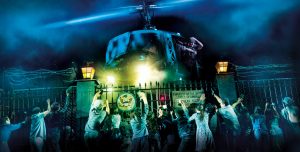Don’t Miss MISS SAIGON at the Kennedy Center
Theater Reviews Page | Previous Theater Review | Next Theater Review
Don’t Miss MISS SAIGON at the Kennedy Center

Posted on BroadwayWorld.com December 18, 2018
There are few entertainments as popular as Miss Saigon (36 million attendees worldwide since it premiered on London’s West End in 1989), and few that have occasioned as much controversy. Despite all that popularity, this reviewer had happened never to see the show until the current national tour surfaced this last week at Washington’s Kennedy Center. Miss Saigon‘s reputation for controversy had preceded it, however, and I was on the lookout for offensiveness. But what I saw was a well-honed crowd pleaser with spectacular stagecraft, excellent singing, a few catchy tunes, and a compelling plot. Some of the provocations complained of in earlier productions are no longer in evidence. In other instances, I would dispute that the material was ever objectively offensive. I’ll discuss all this below, but first, some basics.
Elemental Story
When artists in different media continually return to one story, we can be pretty certain there is something powerful and elemental about it. Puccini told the tale here before in Madame Butterfly, the tragic story of a Western military man and an Asian lover and the child they conceive. It is not insignificant that Butterfly was itself a reworking of a stage play, which in turn was adapted from a short story based on an 1887 novel. Miss Saigon, as is well known, moves the tale from late 19th Century Japan to the end of the Vietnam War. The resituated setting gave the show’s creators Alain Boublil and Claude-Michel Schönberg (the Les Misérables team) scope to explore additional concerns: war, prostitution, international boundaries, war orphans, and the history of the Vietnam conflict. Boublil and Schönberg take full advantage of this opportunity. In today’s environment, the show’s harsh focus on international boundaries, on the peril they pose to the excluded, and on humanitarian efforts to relieve that peril, seems especially poignant. But the heart of the story remains the tragedy of the Asian lover left behind.
With that said, what about the controversies?
No More Yellow-Face
I observed above that some of them are no longer applicable. In the original London and New York productions, there was much unhappiness over the white actor Jonathan Pryce donning prostheses and yellow-face to take on the role of the Engineer, so much so that when America’s Actors’ Equity refused to sanction Pryce for the role on Broadway, producer Cameron Mackintosh canceled the show, and only brought it back after Actors’ Equity relented. Since those original productions, however, all Engineers, including Concepción, have been of Asian heritage. Likewise, in the lovely number The Wedding Ceremony, the original production reportedly had the background chorus of bargirls singing nonsense syllables rather than authentic Vietnamese lyrics; that too has been fixed.
No Fair Blaming the Victim
No Appropriation
There has also been a palpable revulsion expressed by various persons of color, particularly those of Asian heritage, at – well, at what, exactly? I have now read through five separate critiques of this nature, none of them descending from very high and abstract levels of generality. I think what they mean to convey is that white theater-creators playing to a largely white audience and dealing somewhat inaccurately (for instance the nonsense lyrics) with largely Asian subject-matter and in the process foregrounding white characters – and in the same process not telling many other Asian stories – makes these commentators uncomfortable and/or offends them. These comments are sometimes coupled with complaints about “appropriation.”
No Fetishizing
Some of these comments complain about “fetishizing” Asians and particularly Asian women. This is another term with somewhat indefinite meanings. However, to the extent “fetishizing” means prominently featuring scantily-dressed Asian bargirls gyrating to the music in bars or sparkly Asian chorus girls in the Engineer’s big song, The American Dream, a Vegas-y production number, I can only say, that, equipped with a conventional straight male gaze, I did not find such tawdry spectacles a turn-on, and I don’t believe I was meant to. There is a dramatic distance from the depicted encouragement of lust which differs from similar spectacles in, for instance, Cabaret. We are not meant to buy into it at any level.
Some Bathetic Lyrics
My own critiques would go to more mundane matters, for instance the weakness in some of the lyrics. Take the otherwise moving song Bui Doi, about the illegitimate children of American soldiers left behind, which wears out its welcome by the fourth iteration of the bathetic description of them as “conceived in hell, and born in strife.” Or the thrice-repeated characterization of them as “living reminders of the good we failed to do.” Come on, exactly what unachieved good are they reminding us of? Winning the war (the principal good the American effort unsuccessfully pursued)? I don’t think anyone has ever needed to be reminded of that. Marrying the moms? If that were what’s meant, it would require a lot more explanation than an offhand phrase can provide, because the couplings of soldiers and prostitutes in wartime are not ordinarily the stuff from which actual marriages could grow. All that is really meant here, I think, is that we now have a moral responsibility to protect the children. And for that, the phraseology is inapt; the children are not “reminders” of that responsibility; they are its objects.
The “forest” is that this is an excellent contribution to the canon of operatic musicals, richly melodramatic, beautifully acted and sung, with outstanding production values (yes, there is a helicopter!), and intelligent about the effects of war, and – notwithstanding many of the comments I’ve mentioned above – intelligent too about the particular clash of cultures that the war in Vietnam effectuated.
Copyright (c) Jack L. B. Gohn, except for production photo. Photo credit: Matthew Murphy.
Theater Reviews Page | Previous Theater Review | Next Theater Review